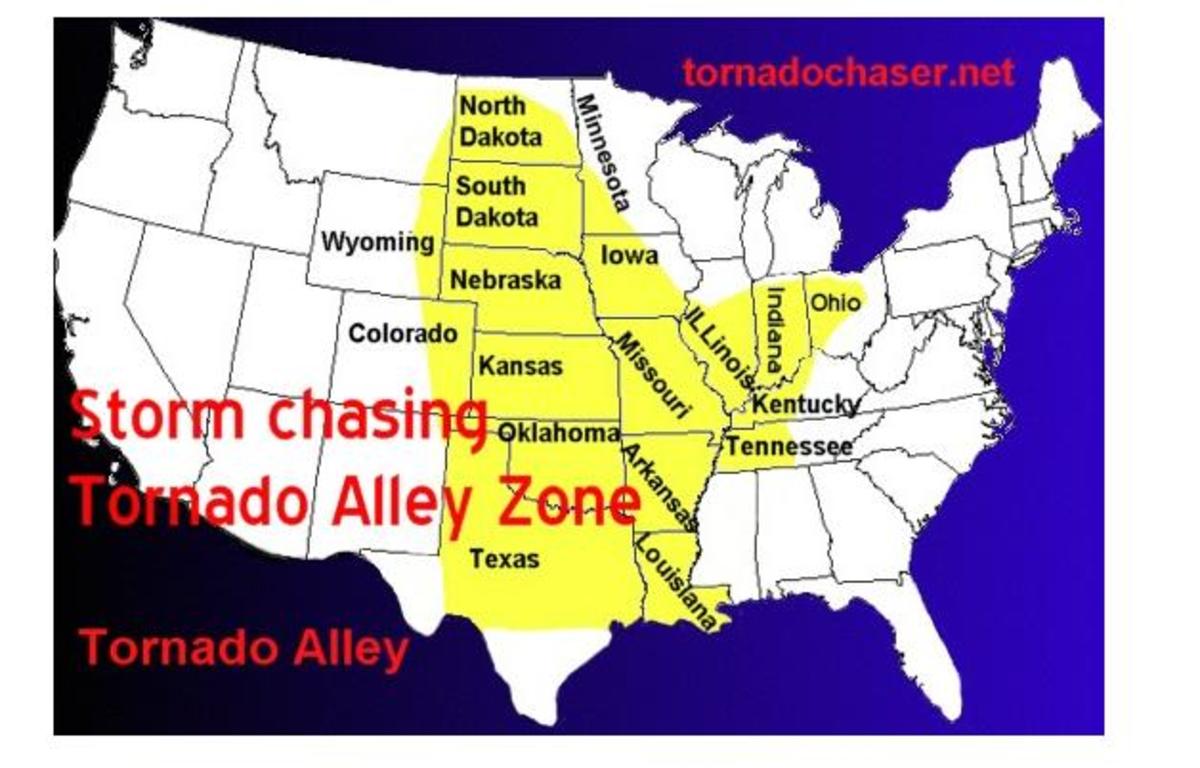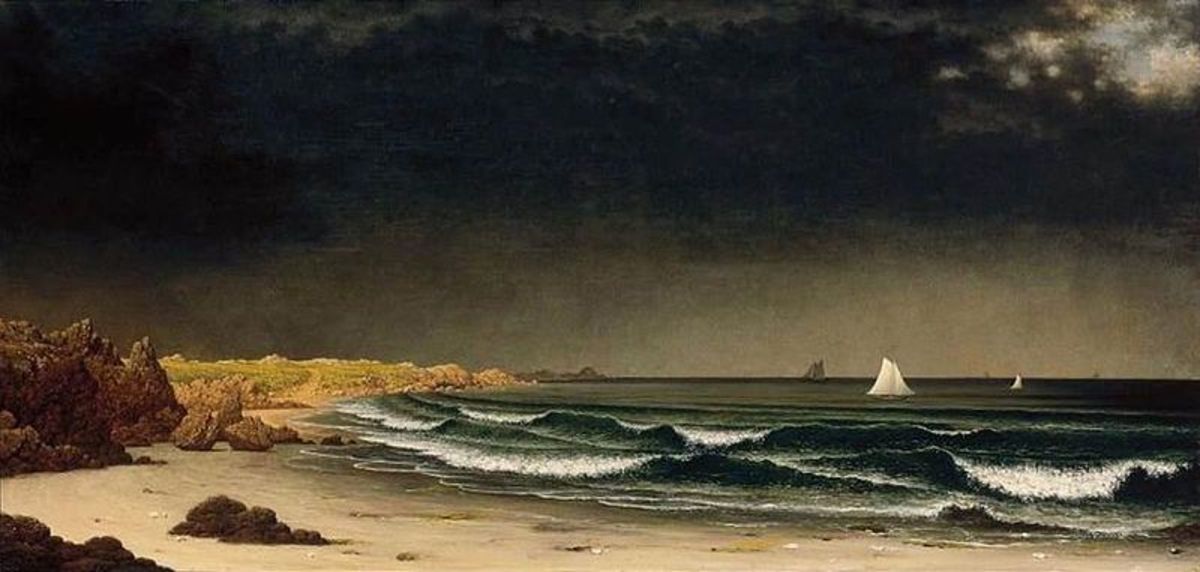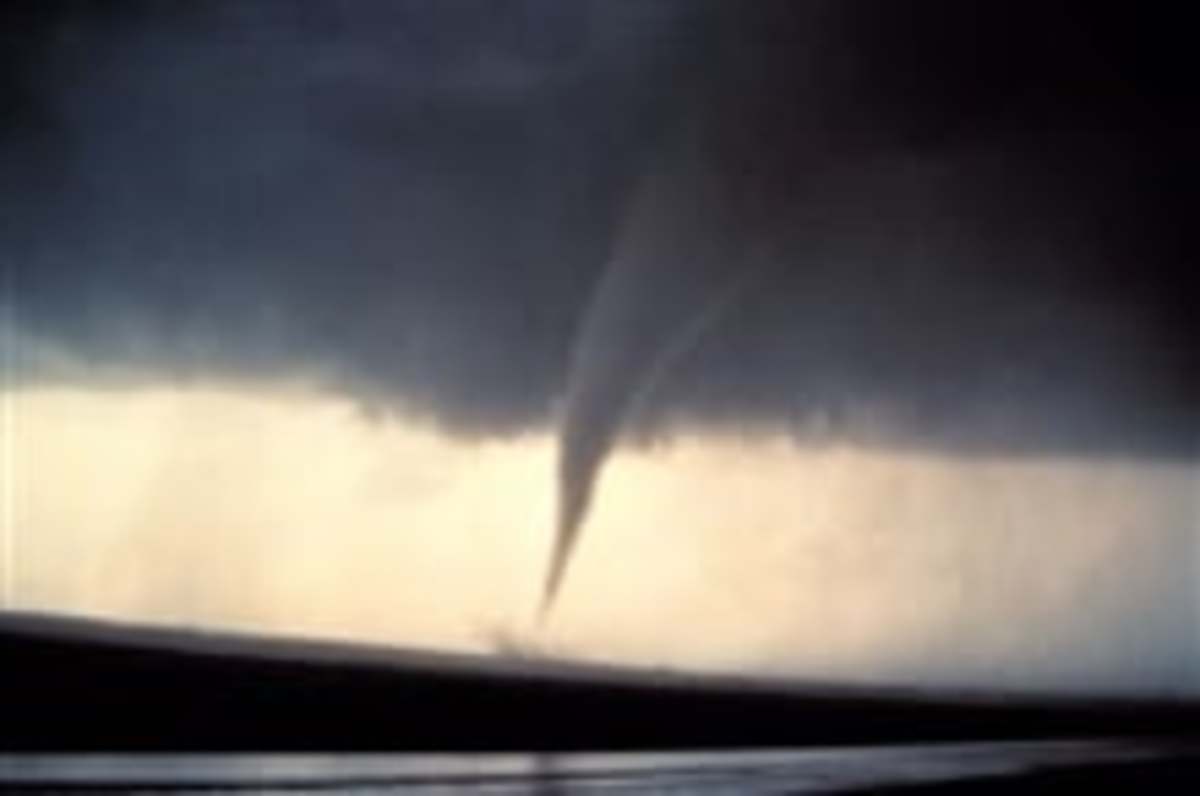Severely Damaged or Destroyed - A Creative Nonfiction Piece About One of the South's Most Damaging Days
The Damage
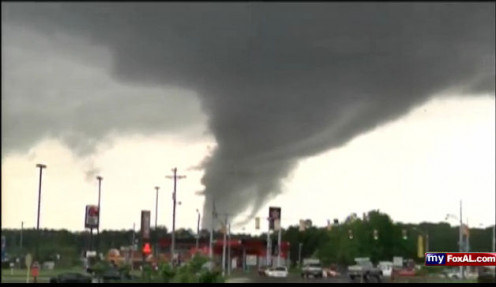
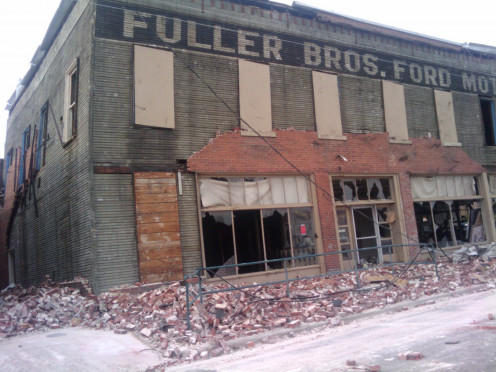
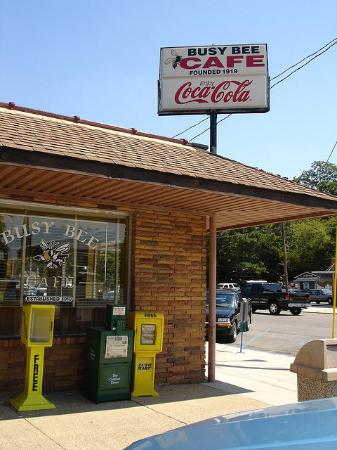
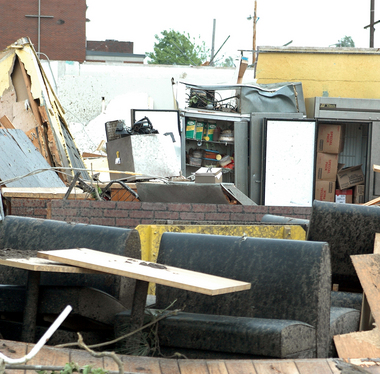
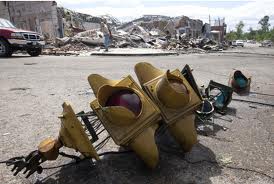
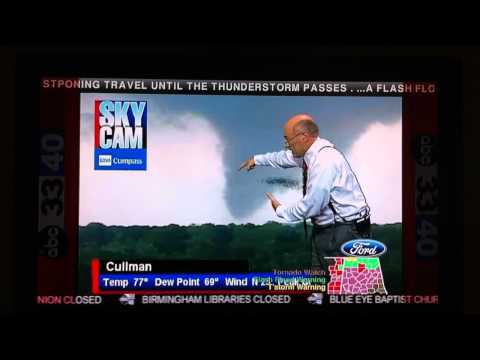
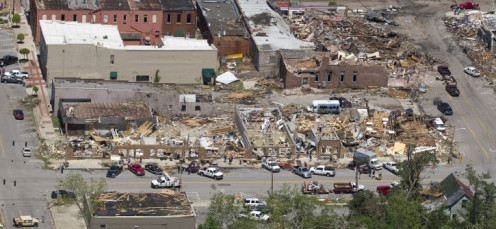
All Clear
“Oh, God.”
My mom sounded like a stranger to me. Worry twisted the tone of her voice into a shadow of its usual cheeriness. I didn’t want to take my eyes off the backs of my parents’ heads where I sat in the backseat of our white minivan. This was the day I’d decide to never again make fun of it for its geeky family vehicle feel.
We had just gotten on the road to leave Sylacauga, a city two hours south of Cullman, my small Alabama hometown. Sylacauga was where we met my dad’s family for Thanksgiving, and once the turkey and talking politics were done we were headed home.
I knew the darkness in my mom’s voice matched it, that thing off to my left that I didn’t want to see.
“What’s he doing, Rodney?” mom said, motioning to the vehicle in front of us, her panic audibly elevating.
“I don’t know, Vestavia,” dad said, calling my mom by her full name. Usually it’s just Stavie or Stave. Or Honey. Or Baby. He stared ahead at the red Chevrolet truck in front of us that kept checking its brakes, speeding up, checking its brakes, before whispering, “Come on, Chuck.” It sounded like a prayer.
We followed my Uncle Chuck down the narrow highway surrounded on both sides by dense woods. The man on the radio gave us the “all clear” we needed to start our journey on this stormy day just moments earlier. I looked over at my little brother, Sam, strapped in his navy blue car seat. He was a year old. I scrounged up my 13 years worth of maturity, and I grabbed his hand. Curiosity gripped me, and I looked over just in time to see the cloud’s gray tail come down, slowly, teasingly circling itself. I blinked, and the tail shot to the ground like a dart.
I was strapped in too tightly. The van seats became our captors in the shallow ditch in which we sat. We had followed Chuck over as the battle of gas-versus-brake ended with brake taking the lead.
I saw the trees on the other side of the road break, snap in half, my face protected from the raging wind and debris by a single minivan window. The drumming of limbs, of dirt and leaves were deafening. The wind’s crescendo drowned out what my parents were screaming in the front seat. It sounded like a prayer.
My hands shook fiercely as I fumbled with the restraints of Sam’s car seat. The windows began to groan under the assault, and my fingers barely got the clasp open. I wasn’t thinking. I wasn’t able.
I knew I had to protect him, my baby brother. I had to get him in the floorboards so that when the windows gave he would be safe. Being sucked into the air, tossed, shredded, or crushed didn’t come to my mind then because all I could see was his face, twisting with fear, eyes brimming with innocent tears at the violence of it all. The van rocked and was pummeled with pieces of tree and earth. I put my hands underneath Sam’s arms, and I was seconds away from freeing him of the straps.
Then I couldn’t hear anything.
The wind died, leaving the van still except for our own shaking. Sam’s whimper filled the small space, and I looked at him, unbuckled and peeping down at me. My knees pressed painfully into the minivan’s floor, and my hands still gripped him. I wondered how long my parents had been holding on to my sweater.
The tornado that day was small, but it was enough to rip a house trailer sitting to our right in half as it made its way over the ditch and through the woods. Inside were three children, two young girls and their own baby brother. They were outside, running toward us before I even knew the trailer was there. One screamed, “I fell with him! I fell!”
We climbed out of the van, without a single bump or scratch, and for a while we shook together near the rubble, three families as one. What was once the siblings’ home was now more akin to an abandoned corner of a junkyard. Our three fellow survivors were scratched and beginning to bruise. The girls told us the story of the wind wrenching their home in half, and how one of the sisters lost her footing and fell while holding the baby boy. They were wound up with adrenaline and terrified for their brother. I could relate.
We called 911, and the oldest of the two girls called their parents who were out for work or errands or... We stayed with them until the paramedics came to make sure the wounds were as mild as they appeared on the surface. They were.
Over the years we’ve relived this story a million times, and we can’t help but tease my uncle about putting us directly in the path of the storm. If we had stopped when we saw the tornado forming, or if we’d gunned it on down the highway that terrifying experience may not be a memory for us now. But with no other houses or businesses for miles those kids would have been alone without us. Sometimes being in the right place at the right time can scare the hell out of you.
I was 13 years old when I learned tornadoes weren’t faceless and unrealized nightmares that woke my family occasionally at 4 a.m. and made us sleep in the basement together. They weren’t invisible villains that blew into town to take a few trees and damage a few houses without being seen. They were real, and now they knew our faces.
Ten years later at 23 the storms returned for retribution, this time within the limits of Cullman County. The April 25-28, 2011 tornado outbreak advanced on my hometown with a power that blasted pieces of it across the Southeast while I watched, powerless, from Auburn, Alabama.
A Short Lesson
A dictionary will tell you a tornado is a dark, funnel-shaped cloud made up of violently rotating winds that may reach speeds of up to 300 miles per hour. These bad boys usually make a path heading northeast, covering ground at about 20-60 miles per hour. Some danger signs include a dark sky with a greenish tint, large hail, low and/or rotating clouds, and a loud roar, most appropriately described by many Southerners on the news as “soundin’ like a freight train.”
Chances are, if you grew up anywhere like I did, you have heard most of this before--a list of scary, clinical-sounding tornado facts that seem perfectly easy to recognize and avoid while the tornado stays safely on the pages of pamphlets and on the screens of televisions and computers.
Cullman, Alabama, a town situated somewhere between the larger cities of Huntsville and Birmingham, had staked its claim in tornado alley long before I was born. The colorful town folk and their experiences offered up some gems on real-life tornado survival over the years. For instance:
1. Hit the ditch! (Or, more formally, get in your basement.)
If you don’t have a basement, refer to steps 2 and 3.
2. For this one you’re going to need to use your best and soberest judgment, as this suggestion is time sensitive. If your home doesn’t have a basement, find yourself a basement to get into.
Score bonus points if you find an official storm shelter. You don’t want to be in the center closet or bathtub of your home unless you just absolutely have to. Again, this is a delicate, time sensitive issue, and if it’s too late just stay put and cover up with mattresses, blankets, and pillows. Dirty laundry works too, though no bonus points will be added. Especially if you’re sober.
3. If you’re driving, look for a ditch. A real one this time.
If you can’t find one, you need to look for another grounded structure, and, if possible, get your butt out of the aforementioned car. In either scenario get low and hold on tight. I know that putting your bare flesh out in the open for the tornado sounds counterproductive, and a little dirty, but all the experts say it.
4.If there’s time, run like hell to the supermarket.
Another time sensitive issue, as everyone else in town will have, no doubt, heard about the storms before you and beat you to the store. Get there. Sweep for bread and milk immediately. For Cullman, the same is true when the threat of snow is present, so this is a two for one lesson. If a single snowflake or threatening raincloud is mentioned on the news, the shelves of the grocery stores in Cullman County are bare. It doesn’t matter if you lose power, somehow you still need the milk. That’s valuable information I’m still reverently waiting to see in action.
5. Insert screams and adrenaline overload as necessary.
This is how those growing up in Cullman County learned to navigate the stormy weather. I pass this knowledge on to you now. Treat it with utmost respect, and I may even teach you our secret handshake.
Where the Wind Comes Sweeping Down the Plain
It’s time for another short lesson, followed by some more relevant information.
So, how are these behemoths created? It all starts with something known as a supercell, or a large thunderstorm capable of producing previously mentioned behemoth.
After some research on the WSAZ News website, I found that the actual tornado is formed “when warm, moist air along the ground rushes upward, meeting cooler, drier air. As the rising warm air cools, the moisture it carries condenses, forming a massive thundercloud.” Warm air goes up, meets the cooler air, warm air cools and boom. That characteristic funnel shape is made when “variable winds at different levels of the atmosphere feed the updraft.”
Here’s the relevant information I promised in the form of a list of tornadic monstrosities from the past. The deadliest single day for tornadoes happened March 18, 1925. Tornadoes struck 7 states and killed 747 people. This includes the Tri-State Tornado, a natural horror movie monster tornado that travelled across Missouri, Illinois, and Indiana, accounting for 695 of those deaths.
The 1936 Tupelo-Gainesville tornado outbreak lasted two days, killing at least 436 people as it blew through. Then we have the Super Outbreak of 1974 that occurred April 3-4 of that year, racking up 148 confirmed tornadoes and 310 fatalities. Tornados have a long history of ruining everyone’s day, and there are countless other storms like these that could fill dozens of pages with death, damage, and destruction.
Like April 27, 2011.
Wake Up Call
“Baby, your phone’s ringing,” I heard, barely, from the foot of the bed where my fiancé sat at his desk, eating his morning yogurt. “It’s your mom.”
I had my head under the covers, suddenly aware of Fresh Prince on the TV and that Cody was tapping my leg with my phone. My eyes barely peeped open when I took it from him just in time for mom to hang up. It was so dark in the little bedroom, the sky outside an ashy, threatening gray.
Mom never calls this early, and when she answered my returning call I knew she was upset. She, along with Dad and Sam, were spending the week in Tennessee on vacation. They were supposed to head home that day that she gave me this wake up call, but that didn’t happen.
“How’s the weather down there, baby?” she asked me, and since I hadn’t seen past the inside of my own eyelids for more than a few seconds I had no idea. I might have said gray.
“Well,” she said. She paused and then her voice broke. Is someone dead?
“Hanceville just got hit pretty hard.”
Someone’s dead.
Hanceville is part of Cullman County on its south side. My fiancé is from Hanceville. My granny lives in Hanceville along with my aunt and uncle and many other cousins, most of which I don’t even know anymore, but with this list I was sure someone was gone.
“This morning your Aunt Rose--” she began. Aunt Rose is dead.
I kept listening as she told me that my aunt just called her and told her about how the giant trees in my aunt’s yard, and if you know this place then you know that the trees are thick as thieves and too tall to see the tops, had been dropping like flies all morning. Aunt Rose isn’t dead.
The morning of April 27, 2011, brought with it a line of severe thunderstorms that were packed with high-powered straight-line winds, not to mention the rotations in the sky constantly threatening to come down.
My older brother, Nick, affectionately calls my mom Local Meteorologist Vestavia Johnston because she’s always making these kinds of calls. If severe weather is present or will be present in the foreseeable future mom lets us know. Usually I take the necessary precautions and my day goes on as usual, but not that day.
“They can’t find your Uncle David.” Damn it.
Uncle David left for work that morning right before the storm dropped. Aunt Rose was alone in her rustic wooden house as she watched the massive, beautiful trees in her yard tip over like toothpicks in a breeze while she panicked for her husband and herself.
I hung up the phone and told Cody everything. I tried to persuade him to stay home from work that day. I can see that “Local Meteorologist” title being passed straight on down from mom to me in the future.
Auburn, Alabama, where I lived so I could attend Auburn University, is three hours south of Cullman, and, though there was an ominous thickness in the air, we weren’t supposed to be hit with anything dangerous until much later that night. War eagle. (Yes, you can say it sarcastically, just not about the actual Auburn Tigers. Or the Toomer’s Corner oaks. Or the lemonade. Or the toilet paper. Or--you know what, let’s just move on before I start singing the fight song.)
Cody left a few minutes later for his job as a project manager for Jennings Construction, and I went straight for my laptop. Facebook had already erupted with status updates and pictures of the damage in Hanceville. With every tree I saw turned over, every piece of mangled debris in the middle of the frequented Highway 31 connecting Cullman and Hanceville, every piece of glass shattered in the buildings of Wallace State Community College and the Fred’s store next door, I thought of Uncle David.
Everyone was overwhelmed with Hanceville getting hit. I spent the morning texting and calling my county friends to make sure everyone was still intact, unlike the collapsed Hanceville High School gym and the forestland around both my aunt and granny’s houses. My other uncle, the one who wasn’t missing, had the roof of his house torn off, but he and his Chihuahua were safe. Everyone I could find was safe.
I was naive enough to think that was the extent of our damage for the day. I knew that the entire Southeast had been warned of severe weather all day, but I thought, Hanceville has been hit. My uncle is missing. It can’t get worse than that.
State of Emergency
That day’s tornado outbreak was part of a massive storm system that swept through the Southeast on April 27, and the surrounding days.
Around 3:00pm Cullman was pummeled by a multi-vortex tornado, because one vortex isn’t quite scary or destructive enough, caught live on TV tower cameras. I watched the footage on TV, and it took me a few minutes to realize I was looking at the city of Cullman. Oh, god. Where is that? I watched chunks of Cullman fly through the air for several minutes before I understood. I picked up my phone and resumed texting.
Have you heard anything? No?
...Have you heard anything now?
I sent a message to Cody telling him what happened as I watched the tornado shred through our hometown on every news station I could find. Facebook showed me the tornado’s damage path spewed across pictures posted by friends. It was an EF4 tornado, a step below the highest level of measurable destruction on the Enhanced Fujita Scale. It made its way straight through the heart of the city along Highway 278 into the historic and business districts downtown and throughout Cullman’s beloved east side.
When Cody returned home from work to find my friend, Stephanie, and I sitting on his bed with two computers open and the TV blaring, shouting warnings and showing clip after clip of debris balls and disfigured buildings. Stephanie’s fiancé, Zach, who worked with Cody at Jennings, was expected to arrive at our tiny bedroom weather station any minute.
At the time, Cody and I both lived in separate four bedroom apartments, complete with too many roommates each, at a complex on College Street. Zach and Stephanie lived in a nice trailer in a neighborhood called Ridgewood, and, since they had no basement, they hunkered down with us for the rest of the day. All of us were squeezed into that bedroom like it was a shrunken T-shirt.
The four of us watched the nightmare as it showed up on one screen, and every other screen in the room would follow suit. Our hands did the work automatically to search for more news.
The sky camera in Cullman caught the EF4 ripping through the center of our town until it was too heavily damaged itself to record anything else. I first saw that on ABC 33/40’s weather blog. Suddenly it was everywhere, just like the pieces of Cullman. We watched it on repeat while fielding frantic phone calls from worried parents and trying to reach all of our friends and family that were unaccounted for in Cullman.
In Pigeon Forge, Tennessee, where my parents and baby brother were staying, the dangerous weather was brewing, but wasn’t quite as fierce as what we were facing in Alabama. My family, along with the rest of that day’s hotel goers, were told to take shelter in the lobby of their hotel. All day, they said. I called them to find out they had left the hotel for a minute to grab lunch.
“Do you see that?” mom said to my dad, and she described the rotating clouds shifting just above the town.
“Mother!”
I yelled for a moment, and I called her mother. I think somewhere in life I’ve tried to make that the equivalent of getting middle-named. Kelsi Rose, get in here now! Kelsi Rose, wait until your dad gets home. It’s terrifying. But it only makes her laugh.
“Okay, y’all please go back to your hotel. I’m trying to keep everyone I love in a somewhat safe place here,” I said.
“You know I’m the mom, right?” mom said, and I knew it was through a smile but I could hear that darkness in her voice again.
As more photos surfaced of the wreckage of downtown businesses, churches, and homes, another announcement was made: Governor Robert Bentley had declared a State of Emergency for Alabama, which authorized state agencies to provide the necessary aid for the state, as well as make and report accurate damage assessments. I rolled “State of Emergency” around on my tongue for a while, but it never tasted right.
The day went on, and we watched tornadoes take on Tuscaloosa, and then Birmingham, and then a string of cities from there on out. Personal possessions, memories, everything that used to be held together in one place, with one heart, was now scattered over hundreds of yards, or in some cases, miles. The phone calls raged on just the same as the storms.
Are y’all still okay down there?
Did you see that?
No, no. It was flattened.
We’re fine. Are you?
They found David!
In the middle of the chaos and the panic and the phone calls a wonderful message from my mom: my Uncle David was found, completely unharmed, just a little shaken. The high-powered winds kept him from making it all the way to work, but he had taken shelter with strangers and called everyone when his phone could dial out of the jammed circuits.
After relaying the message to everyone that my uncle made it through the storm, I continued to scroll down through my Facebook newsfeed. It was like watching a nightmare played out cruelly on rough YouTube videos and the news. The town that I once wished I could leave was leaving me.
Luckily, Alabama is home to a man with a plan.
Stuff Spann Says
“Respect the polygon,” James Spann said. Birmingham’s own “rockstar of meteorology” who belongs to ABC 33/40 has worked in the field since the early 70s. He was named the state’s best weather anchor nine times by the Associated Press and has earned other awards for both himself and ABC 33/40. He told all of us viewers that these “tornado polygons” are an attempt to pinpoint the areas of most severe weather, and he wanted everyone to know they mean business. Looking at the map on the TV, the entire southeast was infected by polygons.The Outbreak just confirmed what most people in Alabama already knew: James Spann was the man.
When Spann’s coat comes off, his suspenders are showing, and his sleeves are rolled up, that usually means we’re screwed. You know his moves are signature and popular with a crowd when he has to say things like, “Please ignore me rolling up my sleeves. It’s just hot. No need to panic.” That’s just one of the “Spannisms” you might see if you head to the Facebook page solely dedicated to this spunky meteorologist, Stuff Spann Says.
Over the years, Spann has taught many of us Alabamians the facts (yes, this is another short lesson):
Why are tornadoes so prevalent in the central and southern parts of the United States? Because the warm and humid air moves up from the Gulf of Mexico, and collides with the air moving down from the Rocky Mountains and Canada, which is cool and dry. When they collide, mayhem ensues.
And what about this Enhanced Fujita Scale? This is a classifying system for tornadoes according to the amount of damage they cause. Formerly known as the Fujita Scale, the Enhanced Fujita scale has the same basic design with improvements in examining tornado damage surveys, ranging from EF1 to EF5. On average, nearly half of all tornadoes in the United States fall into the EF1 category, while there are significantly less EF5 tornadoes, about 1 percent. On April 27, we saw them all.
The National Weather Service confirmed 358 total tornadoes over the course of the outbreak, and here’s the breakdown on where the twisters fell on the Enhanced Fujita Scale:
- EF0: 129
- EF1: 143
- EF2: 49
- EF3: 22
- EF4: 11
- EF5: 4
New sources say that the National Weather Service was able to provide great warning for these tornadoes with an average lead-time of 24 minutes with active warnings in effect for more than 90 percent of the outbreak’s tornadoes. James Spann was always there in the thick of it.
It seems like societies are always looking for a hero, someone to idolize, and this time I feel it’s justified. Thank you Mr. Spann for telling us not to be “boneheads” and try to go out and get pictures of the storms, and for telling us not to go to school or work when the tornadoes are coming through, and that if our principals and bosses have a problem with that they can call you.
I was surfing Stuff Spann Says the other day, and found “ABC 33/40: Where severe weather has better ratings than American Idol!”
I believe it.
Bike Rides & Bologna Biscuits
My hot pink helmet sits atop my hair, an auburn-hued poof of curls fighting the hold of mom’s black scrunchy hair tie’s low ponytail. Shoelaces are tied so they won’t slip into the bicycle’s chain, causing me to tangle and almost wreck like that one time. My fanny pack is securely strapped on and covered with Beauty and the Beast characters. It holds my quarters for the gum ball machine and my Tamagotchi virtual pet. It’s a cat named Pineapple. I’m already sitting on my Huffy impatiently waiting for dad to meet me in the garage.
This was my childhood’s typical sunny Saturday morning.
The Busy Bee Cafe in Cullman, Alabama was old, greasy, smelled like cigarettes, and was a cherished landmark for us Cullmanites. When I was in elementary school, many Saturday mornings saw us making the journey on our bikes because we lived so close to East Elementary School, just a few blocks from the Busy Bee. We would sit in one of the tattered old booths and eat bologna biscuits with mustard.
“I can’t even recognize that. What is that?” I said when a picture overflowing with cracked and beaten boards, crushed brick, and broken glass surfaced on Facebook that day. I was looking at the place where dad and I spent so many Saturdays, completely collapsed and in pieces. Even the old sign on the outside, the one with the faded yellow bumblebee, was gone.
“It just doesn’t seem real,” Stephanie said, sitting on the bed beside me. That was most everyone’s phrase of the day. I kept hearing, it just doesn’t seem real, I can’t believe it. I’m fairly sure if I had a phrase that day it would be something like oh, shit.
I tried to detach the memories I had of this tiny hole-in-the-wall restaurant with this pile of rubble. I focused on the fact that, somehow, no one was killed. As soon as the picture of the Busy Bee was splattered across Facebook news feeds, I tried to hide my tears from Stephanie. I mourned the memories, bologna biscuits and all.
In the Clouds
Shaking a fist to the sky, screaming why, God, why? has been a popular cartoonish means of catharsis in comedic movies and sarcastic sitcoms since before I was born. It provided the wronged characters with some sense of closure in their questioning of random events that weren’t in their favor. It’s silly, watching someone fall to their knees, shouting blame-riddled inquiries and threats to the open air, arms spread wide open. Doesn’t matter if it’s meant as a dramatic joke, or to spark a sympathy for the plight of the character, it usually makes me laugh. But what if this was a common occurrence in real life? What if we couldn’t walk down the street without seeing people kneeling down, face turned upward while challenging the god they see with why me and what now? It’s not such a funny thought. It’s a frightening one. But wouldn’t it be honest?
Cullman is a religious town with a whole lot of churches and a reputation for both piety and prejudice. The number of times a perfect stranger has cringed after learning where I’m from at some party or school function would surprise you. Growing up there taught me a few things about the differences in people and that there’s good and bad in everything. Even the church.
But who among us decides if the punishment fits the crime, and are any of us qualified to make that call? What happens when major change comes to a growing Alabama town, followed by one of the worst natural disasters the town has ever seen?
Here’s where it gets ugly. November of 2010, just months before this hellacious storm, Cullman faced a different kind of experience, one considered a triumph to some, an utmost defeat to others. After being a dry, nonalcoholic town for decades, a vote was taken and the streak ended. Alcohol is finally allowed inside the city limits.Some said the April 27 tornadoes were God’s punishment for the town allowing the sale of alcohol inside the city lines. You won’t see that as a headline in the Cullman Times, at least not right now, but almost every casual debate I’ve heard about the whole ordeal since it happened has at least one person in the group posing the question what if that’s true?
Some don’t even bother making it a question. The way they see it, we were getting what we deserved. I wonder if those people are as tough on the inside, as steadfast on the inside, as they appear while they’re out walking through the rubble that still litters parts of our town. I wonder if they ever just want to give up, get down on their knees in front of God and everybody, and just ask why? Will we ever get any answers if we keep living with our heads in the clouds?
April 27, 2011, has been described as “among the most prolific and destructive tornado days in United States history.” On this day alone, the country saw a record 208 to 211 tornadoes touch down. The death toll for the entire outbreak is 324 people, with 238 of those deaths in Alabama alone. Two people were killed in Cullman County that day as one of those EF4’s made a visit, but by the looks of it in certain parts of town, you might think that not a single person made it out alive.
Ironically, because of that day of suffocating darkness, now there’s a little too much sunlight in Cullman. It’s like someone picked the town up, and placed it in a completely different part of the world, a part without shade. The trees of this town were one thing that many considered as important as Cullman’s elbow to elbow churches. The final Cullman damage count came in at 867 residencies and 94 businesses.
When I came back home for the first time after the storms, my family drove me around the east side of town. Sam pointed to the church that was once his school and said, “See, Kelsi? You can see all their toys and stuff everywhere.” I looked at what was left of the church, and, sure enough, in the pile of dark there were a few brightly colored toys peeking out. The school had closed the doors for the day because Hanceville had gotten hit so hard that morning, otherwise there might have been more than just toys and coloring books in that rubble.
That’s a mighty high price for having a beer on your back porch college football Saturdays.
O Brother, Where Art Thou?
The sun was setting on April 27. Where the tornadoes went, we followed. When they crossed a county line, we made phone calls to everyone we knew there. It was an arduous process that lasted the entire day, and when night fell there was a pause in the action, and I thought I could breathe again. That’s when Mr. Spann said the tornado apocalypse was moving toward Gadsden where my older brother, Nick, and his family lived. I immediately called Nick. No answer.
No answer.
No answer.
No answer.
Again, no answer.
My nerves were frazzled, twisting me into a version of myself I don’t ever want to be again. I felt as though everyone around me spent the 45 minutes that I couldn’t reach my older brother staring at me in horror. I tapped my foot. I had a yelling outburst. I wept. After watching The Outbreak, an affectionate nickname, plow over so many parts of Alabama and the surrounding states, I realized that Nick being blown into oblivion was not only possible, but likely. It was like ten years before. Another brother I didn’t know how to protect.
Hey!
I yelled so loudly everybody jumped when my brother’s deep voice answered the phone instead of the default forwarding voicemail message. I couldn’t help but smile when his laugh reached my ear. He hadn’t been getting my phone calls, but he hadn’t made it home either.
Nick left the Gadsden Times building, where he works as a sports writer, just in time to get halfway home before the head of the storm barreled into Gadsden. The high speed gusts wouldn’t let him keep his car on the road. He happened to drive by the house of some old acquaintances where he pulled over, and was welcomed immediately into the shelter of their home. I could breathe again. Then the Auburn tornado sirens sounded.
Obituary
Kelsi Nuss, death by tornado. Survived by not a single person she knew.
That is my nightmare obituary. The solitary line writes itself on the small corner of a torn newspaper sometimes when my eyes are closed and the wind is kicking up. There is no attention paid to the details of my life. Who would be left to read them?
No tornadoes touched down in Auburn that day. We watched, we waited, we squeezed into the bathroom in a fashion similar to the shrunken T-shirt bedroom. We sat together expecting the worst, but we all slept soundly in our beds that night and took advantage of a warm shower the next morning while much of the state sat quietly in the dark without power for weeks.
The destruction of my hometown was devastating, but many levels under what the people in places like Tuscaloosa and Hackleburg, Alabama, faced. I didn’t lose what many people lost on April 27, or any of the other times a tornado has chased me down. I’m one of the lucky ones, I know, but I’m still asking why?
That first tornado in Sylacauga when I was barely a teen set in motion a fear and morbid curiosity that remains in me now. The person I became when the ferocious whipping whistle stopped was someone completely new. I was aware for the first time of the realness of life, of shredding winds, and the potential for destruction. But I also learned something else. I am not invisible. Not to god, mother nature, or anyone. Neither are you.
What we do, what we say, where we find ourselves--it all means something. The choices we make ripple outward and encounter the ripples of others, sometimes with a smooth wave, sometimes with a crash. It’s all for a reason.
There are days when I can still feel the chase. When the sky groans with thunder. When I feel the wind’s humid breath on my neck. When those weather sirens go off. In those moments I have to work a little harder to hide my fear of the oncoming black sky. Sometimes I bob in the expanse of waterlogged memories those tornadoes gave me, but I always make it back when I remember what they left behind. Then I recall survival steps 1 through 5 and pour myself a glass of milk to enjoy with my slice of bread. I may be damaged, but I am not destroyed.


